Original Title: CoinShares' 2025 Outlook
Original Authors: JEAN-MARIE MOGNETTI, JAMES BUTTERFILL, MAX SHANNON, ALEXANDRE SCHMIDT, MATTHEW KIMMELL, SATISH PATEL, CHRIS BENDIKSEN, MATTHEW KIMMELL, LUKE NOLAN
Translation by: Scof, Chaincatcher
Summary
As we enter 2025, the cryptocurrency landscape continues to evolve at an astonishing pace, influenced by political turmoil, technological innovation, and shifting market dynamics. Next year is expected to be the most transformative year for the industry, with impacts on regulation, adoption, and innovation.
CoinShares is committed to analyzing these key developments, and our 2025 outlook aims to provide the insights and foresight needed to navigate this rapidly changing field. In this report, we delve into the major forces reshaping crypto technology today, such as:
The far-reaching impact of political changes in the United States
The significant growth of Bitcoin mining
The rise of companies focused on Bitcoin returns
Issues surrounding the development of Solana
The fragile growth trajectory of Ethereum
2025: The Year Cryptocurrency Breaks Boundaries
Author: JEAN-MARIE MOGNETTI, CEO of CoinShares
2024 is undoubtedly a turning point for the cryptocurrency industry. The sector has experienced rapid expansion, continuing to build on the solid foundation laid during the previous market downturn. At CoinShares, we have witnessed this growth firsthand, with our assets under management (AUM) nearing the significant £10 billion mark.
We believe this is just the beginning. Recent market developments have prompted us to cautiously consider future trends. In January, the U.S. approved a Bitcoin spot ETF, followed by the approval of Ethereum-related products, which became key drivers of market momentum. We expect more altcoin ETFs to emerge under the approval of the U.S. Securities and Exchange Commission (SEC), although progress may be slower than the market anticipates. Solana appears to be a strong candidate, but established cryptocurrencies like Ripple's XRP and Charlie Lee's Litecoin are also potential competitors.
Regarding Solana, this is a crucial year for the blockchain. Following the collapse of FTX, Solana rebounded quickly and gained favor among retail investors with its user-friendly software, becoming a popular choice for launching meme coins. To compete with Ethereum, Solana needs more than just high throughput. It must attract institutional investors and develop a clear strategy to address decentralization and frequent network outages.
The case of Solana highlights the significant impact of meme coins this year. While some view them as trivial, meme coins have become an important part of crypto culture. Similar to NFT collections in 2020, certain meme coins may gain collectible value in the future or even become "cultural symbols."
Nevertheless, Bitcoin remains our primary focus, with analysts predicting significant growth for the cryptocurrency. The adoption strategy pioneered by Michael Saylor's MicroStrategy has now been widely accepted by miners. Many publicly traded companies are beginning to diversify their financial assets by purchasing Bitcoin, often at the behest of boards and shareholders who see Bitcoin as an ideal hedge. Governments are also working to establish Bitcoin reserves, with U.S. Senator Cynthia Lummis and the initiatives of elected President Trump leading this trend. BRICS nations have also proposed similar initiatives, marking a growing influence of Bitcoin at the government level.
The transformation of the industry is also reflected in the entry of many traditional financial companies into the cryptocurrency market. For example, Robinhood recently acquired Bitstamp, and BONY has finally launched its custody services. As the regulatory environment in the U.S. becomes clearer, we expect an increase in merger and acquisition activity, with valuation gaps and ample capital allowing traditional U.S. financial institutions to re-enter the cryptocurrency competition. Europe will continue to be a primary destination for these transactions.
In the tech realm, the development of AI Agents will redefine the industry. These agents, which operate autonomously on the blockchain, are beginning to trade effectively with one another, bypassing human intervention. Coinbase has already deployed its AI-based on-chain trading solution, a move likely to be emulated.
Bitcoin Trio: Balancing Economic Uncertainty, Geopolitics, and Technological Evolution
Author: JAMES BUTTERFILL, Head of Research at CoinShares
In recent years, CoinShares has focused on monetary policy, particularly its role in shaping Bitcoin as an emerging store of value and the historical inverse correlation between Bitcoin and the U.S. dollar. However, focusing solely on these aspects overlooks Bitcoin's broader potential. We believe Bitcoin will ultimately play a significant role in global trade, driven by its close ties to the growth of the internet and digital infrastructure. Viewing Bitcoin merely as a store of value underestimates its potential.
Economic factors remain important, as the Federal Reserve recently cut interest rates by 50 basis points, despite stable unemployment claims and high market valuations. This move reflects a shift towards supportive monetary policy, thereby boosting investor confidence in Bitcoin. This action indicates that the Fed has begun to lower rates during economic stability and is prepared to support the market through economic downturns, creating a "golden middle ground" scenario. However, this optimism has led to a crowded market, with 80% of investors expecting an economic "soft landing." This consensus may overlook potential risks.
The future economic trajectory has multiple directions. In an optimistic scenario, sustained government spending could stimulate economic growth and potentially increase inflation, especially if import tariffs are raised, although specific policies remain uncertain. Conversely, elected President Trump has proposed including Elon Musk in plans to cut government spending and address national debt. During his campaign, Trump suggested appointing Musk to lead a new "Department of Government Efficiency," aiming to cut federal spending by about $2 trillion. Musk has acknowledged that these measures could bring "short-term hardship," but he believes they are crucial for "long-term prosperity." This partnership underscores Trump's determination to push for significant fiscal reform, leveraging Musk's reputation for improving efficiency and reducing costs. In this new political landscape, the delicate balance between economic growth and low inflation remains critical, but implementing fiscal conservatism could lead to more accommodative monetary policy.
The Fed's policies may stimulate demand through gradual rate cuts (potentially down to around 2.6%), especially in a low-inflation environment. However, the lagging effects of monetary policy mean that this easing may only slowly impact the real economy. Households, particularly low-income ones, face liquidity constraints that limit potential consumption growth, and despite rate adjustments, the real estate market remains sluggish.
Trade and labor supply constraints, along with tightening lending standards, continue to pose challenges. A slowdown in corporate capital expenditures indicates that companies, especially smaller ones, are spending cautiously under financial pressure. Despite improvements in productivity, weak capital spending is viewed as a potential threat to future economic growth.
While the Fed has some maneuvering room in a low-inflation environment, weak job growth and conservative consumer spending suggest that any economic recovery may be slow, requiring patience, and the Fed may implement more extensive easing measures than expected. Historically, there has been a strong inverse correlation between Bitcoin and the U.S. dollar, with the average correlation coefficient based on daily data around -20% since 2018, and a weekly data correlation coefficient of -0.70, although this correlation can fluctuate, as shown in the chart below.
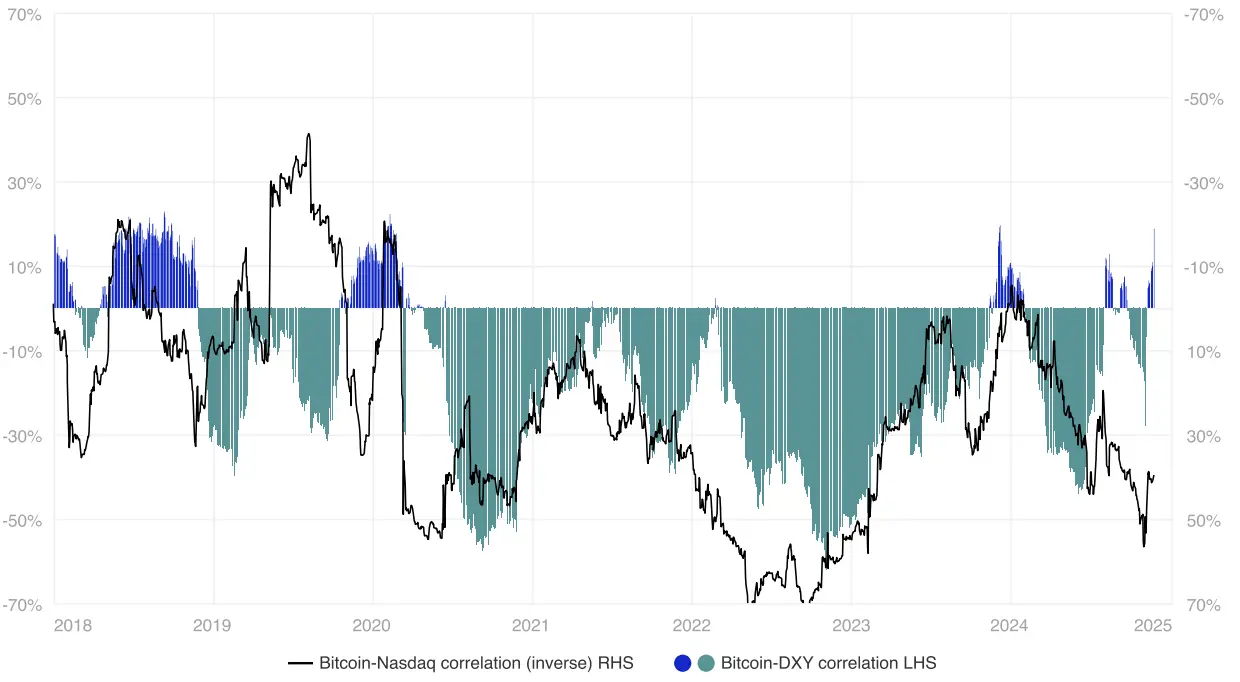
Bitcoin vs U.S. Dollar vs Nasdaq Index. Source: Bloomberg, CoinShares, data available as of close 23 November 2024
This inverse correlation makes sense: Bitcoin is a limited-supply asset best classified as an emerging store of value, competing with traditional assets like gold and U.S. Treasuries. Additionally, the correlation between Bitcoin and the Nasdaq index indicates an interactive relationship between Bitcoin's characteristics as a store of value and its connection to risk assets.
Bitcoin's multidimensional nature stems from its unique role—as both a hedge against the dollar and broader economic uncertainty, and as a technological asset with growth potential. Therefore, we believe Bitcoin may respond differently to changes in monetary policy in 2025 compared to stocks, which are more directly influenced by corporate earnings and macroeconomic trends. When the dollar strengthens, both stocks and Bitcoin may experience varying degrees of capital outflows, depending on the specific context and current economic conditions.
— Key Factors Influencing the Relationship Between Bitcoin, the U.S. Dollar, and Stocks
Strong Dollar vs Risk Appetite
- When the dollar strengthens, it is often driven by economic uncertainty or "risk aversion," leading to a decline in demand for risk assets (such as Bitcoin and stocks). This can explain why, during such periods, the correlation between Bitcoin and stocks tends to increase.
- Conversely, a weaker dollar typically indicates a higher risk tolerance and potential interest rate declines, attracting investors to growth or alternative assets, including stocks and Bitcoin.
Hedging Role of Bitcoin:
We view Bitcoin as a hedge against inflation and currency devaluation, similar to gold. When the dollar depreciates, demand for alternative stores of value (such as Bitcoin and gold) tends to rise. However, over-reliance on the dollar as a reserve currency and safe haven (as held by "dollar extremists") can be as risky as the views of Bitcoin extremists.
Unlike Bitcoin, stocks are closely tied to economic performance and corporate earnings. When the dollar weakens, multinational companies' profits typically increase (in dollar terms), boosting stock performance. However, when the dollar strengthens, stocks may struggle due to shrinking foreign currency revenues, while Bitcoin often experiences capital outflows due to the dollar's attractiveness.
Liquidity and Macro Trends:
In a loose monetary policy and high liquidity environment, Bitcoin and stocks typically perform well. However, during periods of inflation or interest rate hikes, liquidity constraints may negatively impact stocks while also putting pressure on Bitcoin, as seen during the 2022/23 period.
Stocks respond more directly to changes in interest rates and economic policies, while Bitcoin's relationship with these factors is more indirect but still relevant. During market sell-offs triggered by liquidity constraints or economic concerns, Bitcoin occasionally diverges, especially when viewed as a hedge against traditional markets.
Geopolitical Impact on Bitcoin:
Escalating tensions in the Middle East (such as the conflict between Israel and Iran) could disrupt oil production in the region, leading to a surge in global energy prices. Bitcoin, as a "digital store of value," may appreciate under inflationary pressures resulting from rising energy prices.
Historical precedents (such as the oil embargo in 1973) indicate that hard assets like gold—and potentially Bitcoin—can maintain value during energy crises. Additionally, U.S. financial support for Israel may lead to increased debt and monetary expansion, potentially driving up Bitcoin's value against fiat currencies. Bitcoin's decentralized nature also allows it to withstand disruptions in specific mining regions.
In the current economic climate, weak growth may lead Bitcoin to gradually decouple from stock correlations, and by 2025, Bitcoin may also slowly detach from the U.S. dollar.
— Will the Dollar Lose Its Reserve Currency Status in 2025?
The short answer is: not in 2025, but the dollar's dominant position as the world's primary reserve currency is facing increasing challenges from economic, geopolitical, and technological factors. Central banks around the world are diversifying their reserves, with the dollar's share dropping from 71% in 2000 to 59% in 2022 (according to International Monetary Fund data), as a hedge against U.S. policy influence and dollar volatility. Countries like China and Russia are bypassing the dollar for trade to avoid U.S. sanctions, and BRICS nations are exploring a new currency for intra-group trade, with some suggesting it could be Bitcoin. China's Cross-Border Interbank Payment System (CIPS) offers an alternative to the SWIFT system, while digital currencies and blockchain technology provide further means to reduce reliance on the dollar.
Moreover, the U.S. is facing increasing fiscal pressure, with the federal budget deficit reaching $1.833 trillion in 2024. Concerns over a potential post-election debt ceiling crisis have led credit rating agencies to issue warnings about U.S. fiscal stability. This situation, combined with declining foreign demand for U.S. Treasuries, could undermine global confidence in the dollar. As the U.S. struggles to address its debt issues, emerging financial infrastructures like China's CIPS, Russia's SPFS, and Bitcoin offer alternatives to reduce dependence on a dollar-centric system, suggesting a gradual shift away from the dollar's dominance.
— Bitcoin is More Than Just a Store of Value
We often discuss U.S. monetary policy, but that is not the whole story, as Bitcoin's growth potential is often overshadowed by its characteristics as a store of value. The success story of Bitcoin is not merely a cyclical buy-and-sell game; it represents an evolution in finance, attracting individuals, companies, and even governments due to its decentralized and verifiable nature. Far from being a "fragile illusion," Bitcoin's resilience through multiple economic cycles and the ongoing interest from high-profile enterprises and investors reflect its perceived intrinsic value as a hedge against traditional financial risks.
Bitcoin's utility extends beyond speculation; it provides a globally verifiable and secure network without the need for a central authority. This is not just code, but a network governed by consensus that ensures transaction transparency and security. This decentralized model is particularly valuable for individuals and nations seeking financial autonomy, especially in regions with significant economic volatility.
While Bitcoin has yet to match traditional assets in economic productivity, its ongoing adoption and development (such as the implementation of the Lightning Network) have begun to demonstrate practical applications in remittances, microtransactions, and financial inclusion. Viewing Bitcoin solely as a speculative asset overlooks its potential future applications in digital finance and technology.
Record Inflows Signal a Shift for Bitcoin, but Price Surges Remain Challenging Amid Policy and Political Resistance
Author: JAMES BUTTERFILL, Head of Research at CoinShares
As of the end of November, this year's inflows have reached $37 billion. If December does not see a significant market downturn, this inflow amount is nearly three times the previous record of $10 billion set in 2021. This surge is primarily attributed to the launch of the U.S. spot Bitcoin ETF, which attracted $32.6 billion in inflows. After adjustments for outflows from Grayscale, the newly issued ETFs have achieved a record inflow of $50.6 billion to date.
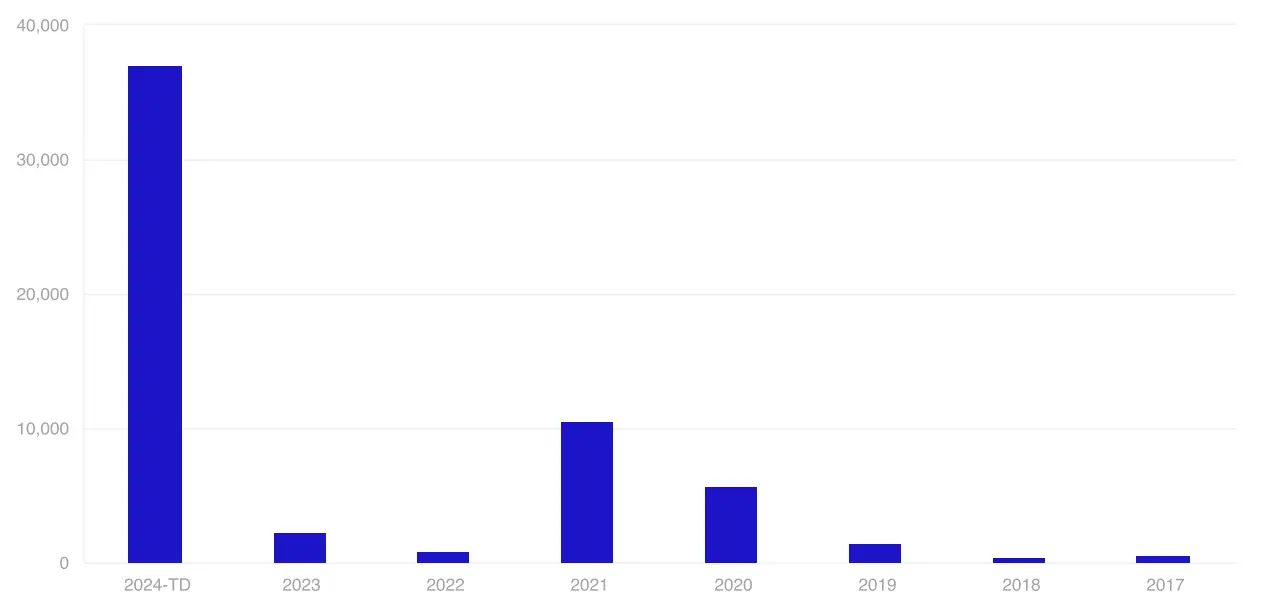 Total inflows into global digital asset funds (in millions of dollars). Source: Bloomberg, CoinShares, data available as of close 23 November 2024
Total inflows into global digital asset funds (in millions of dollars). Source: Bloomberg, CoinShares, data available as of close 23 November 2024
Assuming the total investable assets in the U.S. amount to $14.4 trillion, if 10% of investors decide to allocate $37 billion to Bitcoin, this would reflect an average portfolio allocation of 2.6%. This ratio is double our prediction of 1% at this time last year, which anticipated inflows of $14.4 billion. U.S. ETF providers have now become the second-largest holders of Bitcoin globally, holding 1.08 million Bitcoins, a demand level more than double the 191,000 Bitcoins newly minted by miners. Globally, ETP holders currently custody 1.3 million Bitcoins.
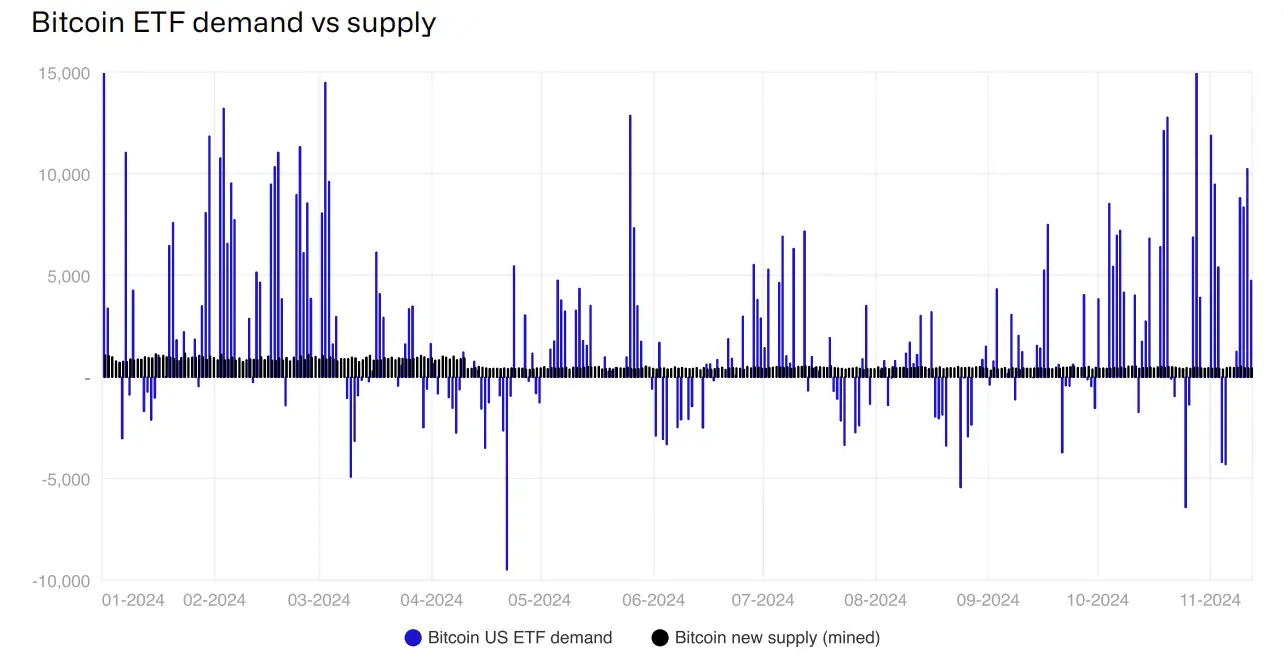
Demand and supply for Bitcoin ETFs. Source: Bloomberg, CoinShares, data available as of close 23 November 2024
This marks an extremely positive event in Bitcoin's history, although we have yet to see the price surge many (including ourselves) anticipated. Based on the relationship between inflows and price (detailed here), our model indicates that at such inflow levels, Bitcoin should have already surpassed the $100,000 mark; however, the price remains around $70,000, near its historical peak. We attribute this to several factors, particularly monetary policy and the political climate, which we believe have recently been the main drivers of Bitcoin's price.
The Federal Reserve's shift in monetary policy took longer than expected, arriving only in September, despite polls in December 2023 predicting this change would occur in March of this year. This delay may be due to a combination of factors, including excess household savings, stronger-than-expected economic growth, and persistently high inflation. Political developments have also introduced adverse factors, with polls indicating that the Democrats may dominate this year, weakening market expectations for a more lenient regulatory stance on digital assets. Additionally, investment platforms have taken time to support Bitcoin ETF trading, while Grayscale's closed-end Bitcoin fund has exerted significant selling pressure, with $18.3 billion worth of funds sold off by previously closed holders this year.
Ethereum funds have underperformed Bitcoin this year. Before Ethereum's launch, the total AUM of Ethereum ETPs accounted for 20% of Bitcoin's. Based on this ratio, inflows were expected to reach $3.2 billion. However, actual inflows were only $1.11 billion, considering the $3.3 billion outflow from Grayscale's existing holdings. This gap may stem from concerns over Ethereum Layer 1 revenues, especially following its Dencun upgrade in June, which we will discuss further.
We are optimistic about the inflow prospects for 2025. With increased political transparency, particularly regarding discussions about the potential influence of the Trump administration, Bitcoin may be viewed as a strategic reserve asset, driving prices up, similar to the post-2020 election trend. Monetary policy also appears poised to remain accommodative, not only in the U.S. but also among many major central banks globally. If the U.S. government were to acquire 5% of Bitcoin's total supply, this would imply an inflow of about $67 billion. Coupled with clear support from the U.S. government, this could encourage hesitant investors to increase their holdings.
Under Trump, the U.S. is Prepared for Major Cryptocurrency Reforms
Author: MAX SHANNON, Research Analyst at CoinShares
With Donald Trump winning the 2024 presidential election, the U.S. is poised for significant changes in cryptocurrency regulation, aiming to become a global leader in the digital asset space. Alongside Vice Presidential candidate J.D. Vance, Trump has pledged to foster a pro-crypto environment focused on innovation, investment, and financial sovereignty.
— Regulatory Reforms
Trump has been openly critical of the U.S. Securities and Exchange Commission (SEC) and its chairman Gary Gensler, particularly regarding the agency's approach to regulating digital assets. Gensler has announced he will resign on Trump's inauguration day (January 20). More SEC commissioners supportive of cryptocurrency could lead to a more favorable regulatory environment for crypto, laying the groundwork for a resurgence in the sector.
Fortunately for the cryptocurrency industry, Trump's Vice President Vance has previously been dedicated to promoting regulatory clarity. Vance has drafted proposals aimed at reforming the regulatory approach of Washington's two major regulatory bodies toward cryptocurrencies.
Coinbase, A16Z, and Ripple are the 9th, 10th, and 11th largest donors to Trump's campaign: while below Citadel or Susquehanna, they are above companies like Bloomberg and Blackstone. Super PACs that solely support cryptocurrencies, such as Fairshake, Defend American Jobs, and Protect Progress, rank as the 8th, 13th, and 17th largest fundraising organizations, respectively. This will help push pro-crypto legislation in a Republican-majority House and Senate.
Both Trump and Vance support the FIT21 reform of market structure and are willing to end "Operation Chokepoint 2.0," accepting stablecoins to strengthen the dollar's dominance internationally. This should have a positive impact on altcoins and M&A activity, as traditional financial companies will gain more clarity and confidence in the crypto asset space.
— Support for Bitcoin Mining
The Trump administration plans to make the U.S. a global center for Bitcoin mining. Throughout the campaign, Trump met with miners and promised to protect their operations, emphasizing that Bitcoin mining is crucial for financial independence and national security. He views Bitcoin miners as defenders against central bank digital currencies (CBDCs), which his administration opposes. At the Bitcoin 2024 conference, Trump pledged to "retain 100% of the Bitcoin currently held or acquired by the U.S. government… this will effectively become the core of the national strategic Bitcoin reserve."
Trump's newly appointed pro-crypto Treasury Secretary Scott Bessent, a successful hedge fund manager, and Howard Lutnick, CEO of the pro-crypto financial services firm Cantor Fitzgerald, have been nominated to lead the government's trade and tariff strategy as Secretary of Commerce. These appointees may support Trump's grand vision for Bitcoin as a fiscal reserve asset. While skepticism is warranted regarding Trump's statements, they are undoubtedly positive.
In the short term, miners focused on Bitcoin mining may outpace those who have diversified their revenue sources, such as those involved in artificial intelligence or machine manufacturing.
— Self-Management and Financial Sovereignty
Trump is also a staunch advocate of self-management. At the same meeting, he pointed out that he believes individuals should control their digital assets without government intervention. However, Trump's positions on issues like sanctions and bank secrecy laws tend to be neutral or conservative. Therefore, his ambitions for self-management may face challenges, especially concerning issues like funding illegal activities or money laundering. While this policy may not directly impact Bitcoin's price or individuals, it represents a positive step toward the protection of private property in the U.S.
— Economic Outlook for Cryptocurrencies
Trump's economic policies lean toward fiscal and monetary expansion; he supports further tax cuts and hopes the Federal Reserve Chair will adopt a dovish stance, lowering interest rates, increasing the debt burden, and driving cheap capital into risk assets like cryptocurrencies.
In summary, Trump's victory signifies a pro-crypto government, with policies supporting Bitcoin mining, self-management, banking and market structure regulation, and the legalization of stablecoins, creating a favorable environment for innovation and growth in digital assets. As the U.S. shifts toward these policies, Bitcoin still has the potential to be one of the best-performing assets in 2025, while other altcoins may stand out even more.
The Boom of Bitcoin Mining and AI: Debt, Mergers, and Clean Energy
Author: MAX SHANNON, Research Analyst at CoinShares
— Miners Increasing Debt Market Usage as Interest Rates Decline
As interest rates gradually normalize, Bitcoin miners are expected to return to the debt market. Companies like TeraWulf, Core Scientific, Marathon Digital, and Bitdeer Technologies have already raised over $2.5 billion through convertible bond issuances. This trend may continue, with miners utilizing these tools to lower capital costs, fund strategic growth, and manage existing debt more effectively. Given the high volatility of the industry, this financing method is particularly attractive due to the barriers to entry in traditional debt markets.
With high interest rates and industry volatility making access to traditional debt markets more challenging, convertible bonds provide a more balanced approach to capital structure management with lower dilution. By reducing reliance on equity financing, these companies can pursue diversified strategies, as reflected in the differences in their convertible bond pricing.
Another form of debt financing is also showing some potential. As miners accumulate more Bitcoin on their balance sheets, Bitcoin-backed financing is expected to grow. We have already seen this, such as Marathon's $200 million credit line, followed by Canaan's $22.3 million loan secured by 530 Bitcoins. This trend aligns with the rising value of Bitcoin, making it a more valuable collateral. Thus, miners can issue more depreciated fiat debt based on their increasing Bitcoin holdings, enhancing their financial leverage.
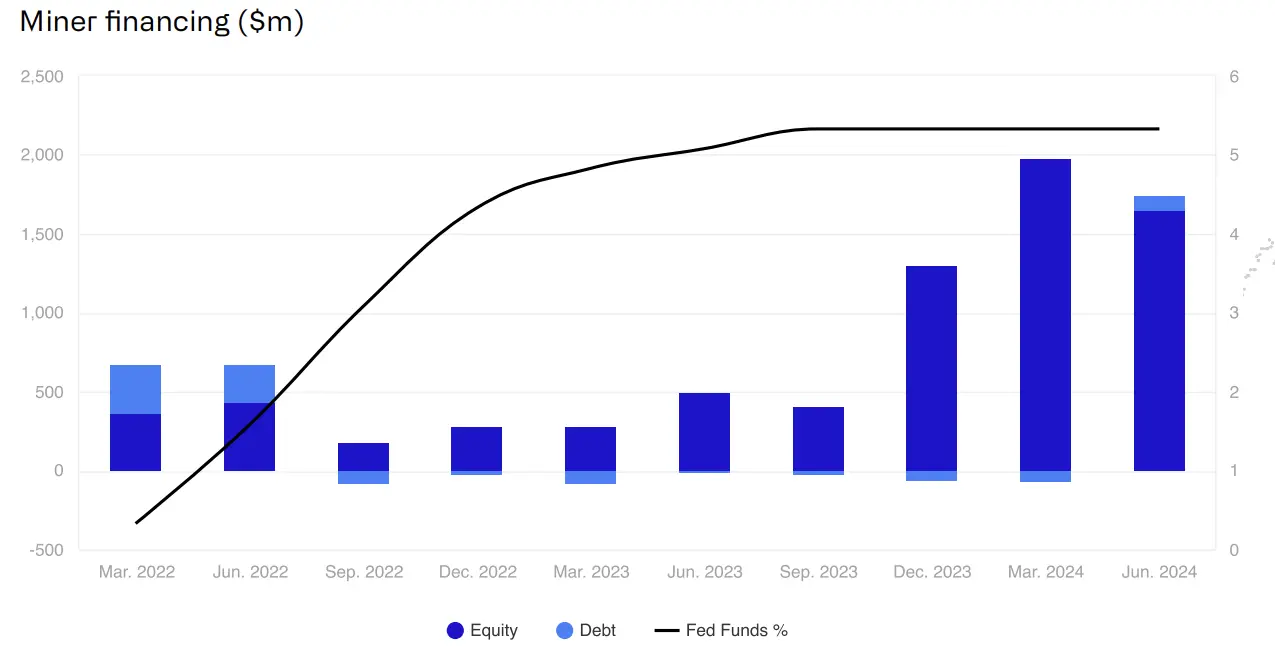
Miner Financing (in millions of dollars). Source: Bloomberg, CoinShares, data available as of close 01 October 2024
— Further Mergers Among Miners
Acquisition activities among miners, such as Cleanspark's acquisition of Griid, Riot's deal with Block Mining, and Bitfarms' acquisition of Stronghold (all focused on operational facilities), are expected to increase. Acquiring distressed or turnkey mining sites is more cost-effective than building new facilities from scratch. Developing greenfield projects typically takes years, while acquiring and upgrading existing infrastructure can be completed in just a few months. This significantly shortens the time to market and accelerates returns, making it a strategic focus for miners.
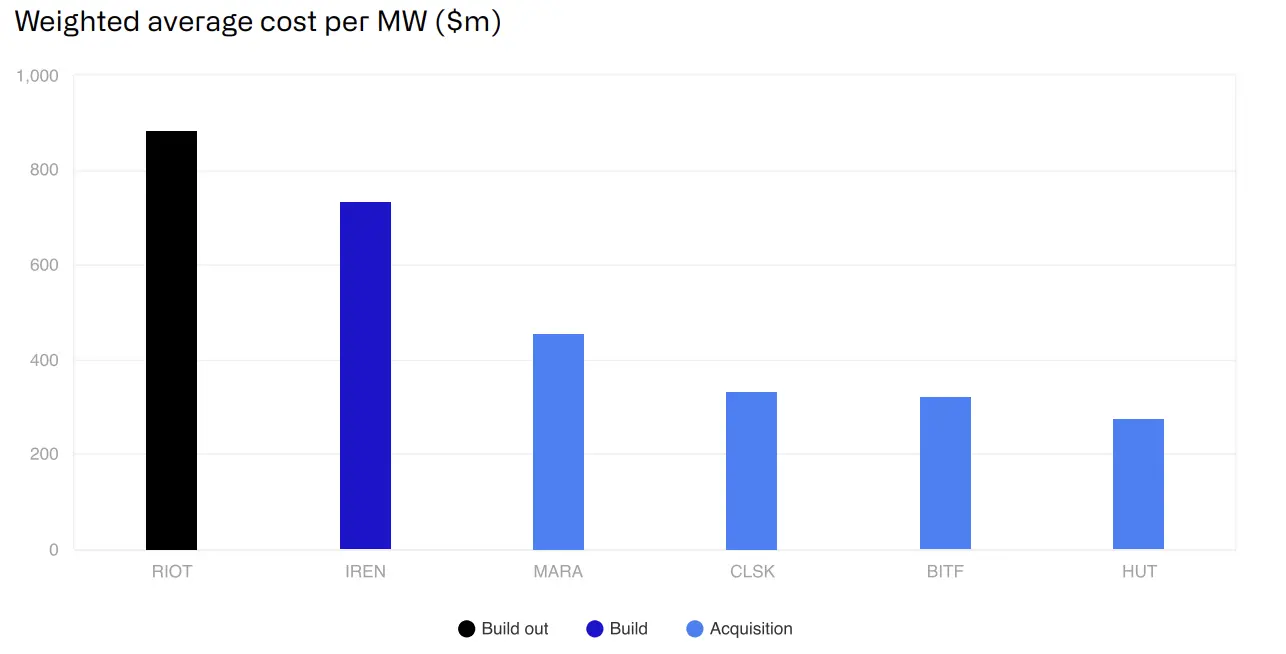
Weighted Average Cost per Megawatt (in millions of dollars). Source: Industry Sources, CoinShares, data available as of close 17 October 2024
— AI Supercomputing Companies Focus on Clean Energy Triple Redundancy
Miners may continue to sign land acquisition option agreements to expand their energy portfolios in anticipation of upcoming hash rate and/or GPU computing capacity. We believe the most favored site characteristics are Tier 3 clean energy redundancy and gigawatt-level power supply pipelines. For example, TeraWulf's Lake Mariner site relies entirely on hydropower, with management stating that the site's power usage efficiency (PUE) is 1.2. Located in New York, the climate is cooler than Texas, and by directly drawing water from the lake, they can further reduce PUE.
Once these high-quality clean energy sites are fully utilized, the focus may shift to regions with strong renewable energy mixes, such as the PJM power interconnection market (approximately 60-65% renewable energy). Based on this, Bitdeer's site in Ohio (reaching 791 megawatts by FY 2027) and TeraWulf's Nautilus site (2.5 gigawatts) may gain a competitive advantage.
Therefore, we expect companies with clean energy capabilities or located in attractive regions to be more likely to attract AI partnerships than those heavily reliant on less ideal locations like Texas.
The End of the Three Giants in Bitcoin ASIC Mining
Author: ALEXANDRE SCHMIDT, CoinShares CFA - Index Fund Manager
Since the launch of the first Canaan Avalon chip in 2013, the ASIC manufacturing industry has been dominated by a few key players. China has been at the core of this industry, with the vast majority of ASIC designers and manufacturers located there, a situation that has not changed even after the government implemented a mining ban in 2021. Today, the market effectively presents a monopoly of three giants, with Bitmain dominating, followed by Canaan and MicroBT (collectively referred to as the "three giants"). Although all are headquartered in China, they also have manufacturing facilities abroad.
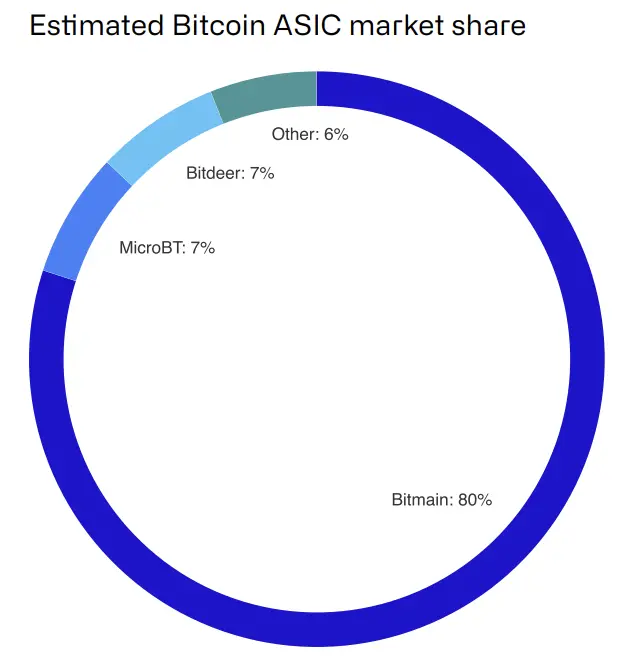
Estimated Market Share of Bitcoin ASICs. Source: Estimated by CoinShares
As Bitcoin adoption and prices grow, mining has evolved into a more specialized industry. Since the introduction of the first ASIC chip, the Bitcoin network's hash rate has increased from about 1 PH/s to over 600 EH/s today, a growth of 600,000 times. Following Moore's Law, each new generation of mining machines has seen significant improvements in performance and efficiency, driving down manufacturing costs and the price per hash.
The Bitcoin ASIC market has become quite large. Canaan's 2019 IPO documents indicate that the Bitcoin mining machine market grew from $166 million in 2014 to $3.2 billion in 2018. Over the past three years, the Bitcoin network's computing power has grown by 100 EH/s to 200 EH/s annually. While not all growth comes from newly purchased equipment, given the current mining economics, only the latest generation of efficient mining machines can be profitable, leading us to believe that nearly all growth comes from newly acquired machines. Based on the current price of mining machines at about $15 per TH/s, we estimate that the Bitcoin ASIC market will range from $15 billion to $30 billion in 2024, a figure confirmed by industry insiders.
— New Entrants Challenge Traditional Giants
As the market regained momentum in the second half of 2023, new projects began to emerge, particularly those from Auradine, Bitdeer, and Block Inc. This is the first time since the advent of ASICs that several competitors are simultaneously accelerating the launch of new, high-performance mining machines that could ultimately challenge the existing industry giants, especially Bitmain.

The horizontal axis lists: Manufacturer, Latest Model, Efficiency, Release Date. Source: CoinShares, ASIM Miner Value, company data (as of 16 October 2024)
The biggest question is whether these new projects will succeed or if we will see another brief period of glory for mining machine startups. Auradine is a U.S.-based Bitcoin ASIC design company that has received a $49 million investment from Marathon, whose CEO Fred Thiel also serves on Auradine's board. Auradine's first Teraflux mining machine is set to launch in Q4 2023, with its latest model achieving an efficiency ratio of 15 to 16 joules per terahash (J/TH), nearly comparable to Bitmain's latest Antminer S21 XP Pro (efficiency of 13.5 J/TH). According to CEO Sanjay Gupta, the company already has over 30 customers, with Marathon seemingly being the largest, having paid $44.1 million in advance over the past year.
Bitdeer is a publicly traded company that was spun off from Bitmain in April 2023, initially operating solely as a Bitcoin mining company. In March 2024, the company announced the launch of its own Bitcoin mining machines, utilizing the SEAL01 chip. By September 2024, Bitdeer completed testing of its SEAL02 chip, achieving an efficiency of 13.5 J/TH under underclocked settings. These chips have been integrated into Bitdeer's SEALMINER A2 mining machines, which began mass production in October 2024. Bitdeer's competitive advantage lies in hiring former Bitmain engineers who have successful experience in the large-scale rollout of Bitcoin mining machines and possess industry connections that can ensure supply chain agreements.
The last entrant is Block Inc., which is developing Bitcoin mining machine chips using a 3-nanometer process. Led by Twitter founder and Bitcoin advocate Jack Dorsey, Block aims to "democratize Bitcoin mining." While Block is primarily viewed as a fintech company, it has accumulated significant ASIC experience by developing chips for the Square point-of-sale system. In July 2024, Block announced a partnership with Core Scientific to develop and deploy 15 EH/s mining machines using Block's new chips. This project involves collaboration between Block's Proto team, ePIC Blockchain Technologies, and Core Scientific. However, unlike Auradine and Bitdeer, the collaboration between Block and Core Scientific has yet to release a working prototype, and it remains unannounced whether Block's chips or jointly developed mining machines can be widely commercialized.
— The Success of New Competitors Depends on Reliability and Scale
Whether these emerging competitors can challenge the dominance of the "big three" manufacturers largely depends on their ability to successfully launch usable products and rapidly scale production. This, in turn, relies on ensuring capacity at semiconductor manufacturing plants. Additionally, skepticism from mining operators regarding new products, particularly concerns about their reliability, poses a challenge. However, the emergence of new competitors is welcomed as it has the potential to weaken the pricing power of the big three, thereby prompting mining machines to become more efficient and ultimately achieve higher profitability.
Bitcoin's Rush into the U.S. Financial Sector
Author: MATTHEW KIMMELL, Digital Asset Analyst at CoinShares
Since its launch in February, the U.S. Bitcoin ETF has achieved tremendous success. Among the 575 ETFs launched in the U.S. in 2024, the top four by inflows are all spot Bitcoin products: IBIT, FBTC, ARKB, and BITB. In the ten months following their launch, there have been positive inflows in nine of those months. In less than a year, the total holdings of these spot Bitcoin products have approached 1 million coins, nearly equivalent to any known holding entity—this is substantial, although still slightly less than the estimated 1.1 million Bitcoins held by Satoshi. In comparison, the inflow of Bitcoin ETFs in their first year reached this level, while gold ETFs took five years to achieve the same since their launch in 2004. Such strong demand raises an important question: who is buying these ETFs? Can their inflows be sustained?
— Professional Investors Hold 20% of U.S. Bitcoin ETF Assets
Through 13-F filings, we can gain insight into the sources of investors purchasing these ETFs. These filings are submitted by investment managers managing over $100 million in assets, indicating that approximately 20% of the assets in U.S. spot Bitcoin ETFs are held by professional institutions and fund managers, meaning the remaining 80% primarily comes from retail investors or smaller financial professionals.
According to the 13-F forms, there are over 1,200 holders of these ETFs. Among them, 984 are investment advisors, accounting for 78% of all filers, but they only represent 41% of the total assets under management (AUM). Understanding the backgrounds of these investment advisors helps provide a more comprehensive view; for example, Goldman Sachs, with a holding of $741 million, may be acting more as a general liquidity provider, while firms like Ark Investment Management and VanEck hold $206 million and $80 million, respectively, and have launched their own spot Bitcoin products.
Hedge funds also hold a significant portion, with larger average positions and portfolio weights. A total of 138 hedge funds hold these ETFs, collectively accounting for 38% of the total assets reported in 13-F filings. Notable holders include Millennium Management, Schonfeld Strategic Advisors, and Aristeia Capital. We suspect that the stability of these inflows may be weak, as hedge funds tend to be more opportunistic in their allocations. Additionally, basis trading has been very attractive this year, potentially serving as an important source of hedge fund demand.

Daily Trading Volume of U.S. Spot Bitcoin ETFs (in dollars, billions) vs. Annualized Rolling Basis (3 months) — All Exchanges. Source: Bloomberg, Glassnode, CoinShares, data available as of 22 November 2024
— Bitcoin ETFs Likely to Continue Their Success
The future trajectory of Bitcoin ETFs depends on several factors. Encouragingly, the number of 13-F report filers increased by 20% from March to September 2024. This growth primarily comes from institutions classified as investment advisors, indicating that the adoption of Bitcoin ETFs is on the rise. However, while hedge funds still account for a significant portion of AUM, they are more inclined to trade rather than hold these ETFs long-term. If market sentiment changes or certain trades reverse, these funds may quickly exit their positions, leading to outflows.
Another factor to consider is that the allocation of Bitcoin ETFs in portfolios is relatively small. Bitcoin is still widely viewed as a high-risk asset, with many managers categorizing it as an "alternative investment"—often referred to as digital gold. Compared to stocks and bonds, the scale of alternative investments is typically smaller, limiting their potential allocation in portfolios. Nevertheless, Bitcoin ETFs have been listed for less than a year, and many professional investors may still be obtaining internal approvals or conducting due diligence through investment committees.
Given the market size of U.S. financial professionals, even a small portfolio allocation could lead to substantial inflows, provided Bitcoin becomes a standard component of modern portfolios. However, the inclusion of Bitcoin is not yet widespread, but its clear advantages as a risk diversification tool have been recognized, with several encouraging examples already in place. For instance, Fidelity has incorporated its FBTC product into its all-in-one conservative ETF; Michigan and Wisconsin have included Bitcoin ETFs in their state pension funds; and recently, Emory University has also held some Bitcoin ETFs in its endowment fund investment portfolio.
From a retail perspective, this still seems to be the dominant source of demand for Bitcoin ETFs, with room for growth. Certain brokers, such as Vanguard, have yet to open access to Bitcoin ETFs. Once they launch these services, and companies like Fidelity, Robinhood, and Interactive Brokers continue to provide access channels, the number of retail participants may further increase.
— The Outlook for U.S. Bitcoin ETFs Looks Optimistic
The launch of Bitcoin ETFs clearly demonstrates the demand from U.S. investors to gain exposure to Bitcoin through familiar financial products. These ETFs have not necessarily triggered an urgent assessment of Bitcoin's investment potential by professional financial managers, but given market demand, smooth internal approval processes, and the pressure from peers gradually recognizing Bitcoin as a viable asset, we expect more assessments to follow.
Gaining access is the first step, and evaluation is the next—this process may gradually unfold over time. Bitcoin enthusiasts should be cautious in claiming that "institutional money has arrived," as the allocation ratio in portfolios is relatively small, and the institutions in the 13-F reports only account for 20% of total assets under management. Nevertheless, there are still many exciting developments.
The rapid success of these products fully reflects the strong demand for Bitcoin, and if professional investors begin to view Bitcoin as a standard part of their portfolios, it could drive greater adoption. The journey of Bitcoin ETFs has just begun, and the future looks bright.
The Rise of Bitcoin Yield Companies
Author: SATISH PATEL, CoinShares CFA - Investment Analyst
Bitcoin yield companies are reshaping the landscape of corporate finance, with an increasing number of businesses treating Bitcoin as a reserve asset. This trend reflects Bitcoin's potential not only as a store of value but also as a means of generating yield. The yields mentioned include:
- Growth of Bitcoin holdings relative to company stock;
- Yield farming, which generates returns by lending out Bitcoin;
- Alternative strategies for creating income through derivatives to benefit from Bitcoin reserves.
MicroStrategy has become synonymous with corporate Bitcoin investment, holding 402,100 Bitcoins valued at approximately $39.8 billion as of December 5, 2024. The company has introduced its own "BTC Yield" metric to measure the effectiveness of its strategy, helping investors understand how Bitcoin acquisitions create value for shareholders. For a detailed analysis of the MicroStrategy investment case, please refer to our in-depth analysis.
Similarly, Block has committed to using 10% of its Bitcoin product profits to acquire Bitcoin, effectively adopting a dollar-cost averaging strategy to enhance its reserves. Bitcoin mining company Marathon Digital has also taken a similar approach to MicroStrategy, using low-interest debt to acquire Bitcoin. In August 2024, the company issued $300 million in convertible bonds with an annual interest rate of 2.125%, followed by $1 billion and $850 million in financing in November and December 2024, respectively, at a 0% interest rate. This approach allows Marathon to take advantage of favorable borrowing conditions to increase its Bitcoin reserves.
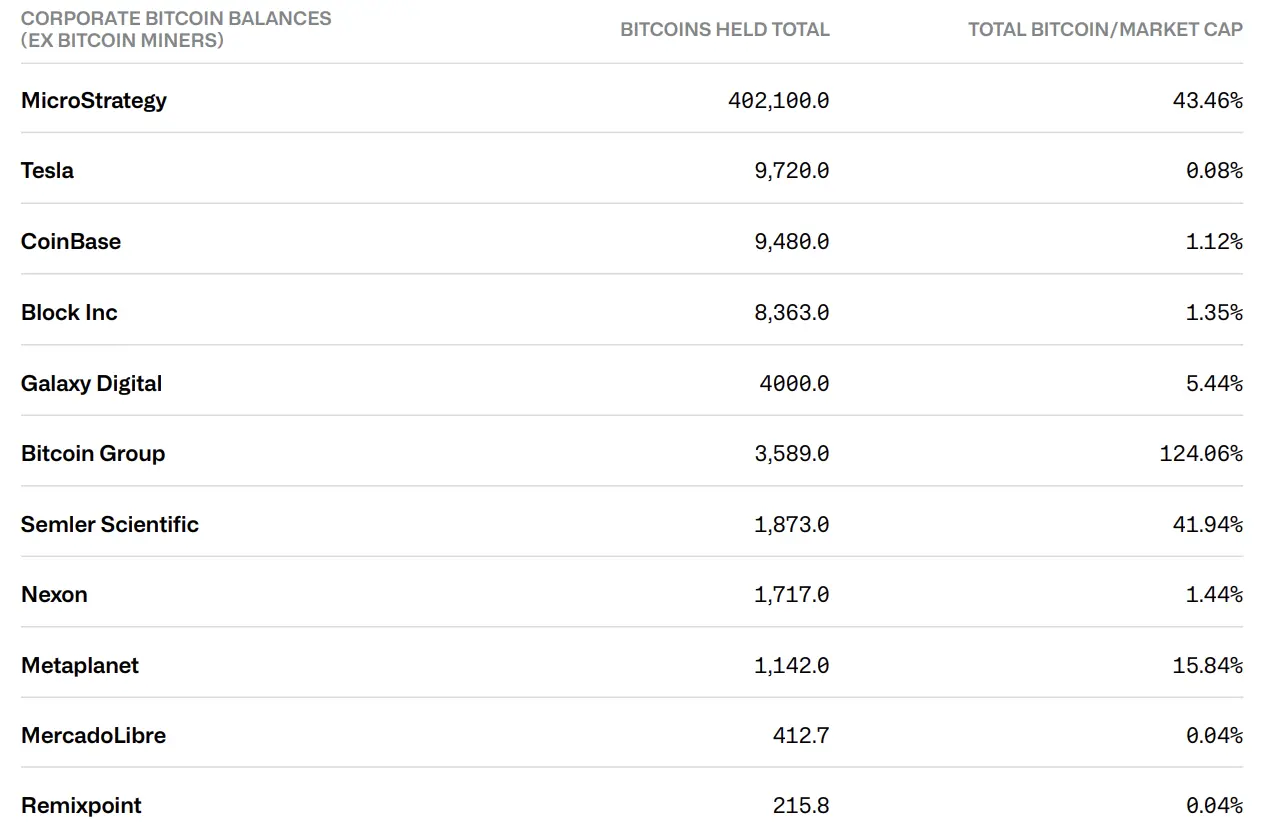
Horizontal axis: Corporate Bitcoin Balances (excluding Bitcoin miners), Total Bitcoin Holdings, Total Bitcoin Holdings/Market Cap. Source: BitcoinTreasuries.net, Bloomberg, CoinShares, data as of December 5, 2024.
A significant development this year is the U.S. Securities and Exchange Commission (SEC) allowing BNY Mellon to classify Bitcoin and other cryptocurrencies as assets rather than liabilities, enabling the bank to provide custody services for cryptocurrency exchange-traded products. This classification aligns with MicroStrategy's efforts to improve the accounting treatment of its Bitcoin holdings, which previously faced impairment losses under current GAAP standards. By viewing Bitcoin as an asset, companies like MicroStrategy can present a more favorable financial position, potentially mitigating the negative impact of Bitcoin price volatility on reported earnings. Additionally, this change may enhance MicroStrategy's ability to borrow Bitcoin at typical market rates (4-6%), offsetting its interest payments.
Semler Scientific, a medical technology company, has adopted Bitcoin as a primary reserve asset, holding 1,873 Bitcoins valued at approximately $185 million as of December 5, 2024. Furthermore, the traditional Japanese hotel company Metaplanet has also begun accumulating Bitcoin and has implemented MicroStrategy's BTC yield metric. As of December 5, 2024, the company holds 1,142 Bitcoins and is actively generating yield through Bitcoin options, planning to achieve profitability this year. These initiatives highlight a trend of traditional and tech-oriented companies increasingly turning to Bitcoin yield strategies, which is expected to accelerate in 2025.
In 2024, more large companies began accepting cryptocurrencies as a means of payment, suggesting that more companies may incorporate Bitcoin into their reserves in 2025. For instance, luxury car manufacturer Ferrari has started accepting cryptocurrency payments in the U.S. and plans to expand to Europe. Additionally, Microsoft is evaluating a shareholder proposal to consider incorporating Bitcoin into its investment strategy, with a decision expected at the meeting on December 10, 2024. Retailers such as AT&T, Whole Foods, Home Depot, and AMC Theatres are also accepting Bitcoin payments through platforms like BitPay, Flexa, and Spedn, indicating a growing acceptance across industries. Currently, e-commerce giants like Amazon, Shopify, Nike, Expedia, and PayPal have already engaged in the cryptocurrency space, whether through payments or investments, and may consider incorporating Bitcoin into their reserves in 2025.
According to data from BitcoinTreasuries.net, as of December 5, 2024, the total amount of Bitcoin held by corporations reached approximately 939,190, a significant increase from 80,000 in December 2020, with publicly traded companies holding 528,772, about 2.5% of the total Bitcoin supply. This strong accumulation trend is expected to continue and may further strengthen in 2025, especially as regulatory clarity and political developments create a more stable framework for corporate investment in digital assets.
Focus on the Latest Developments in the Lightning Network
Author: CHRIS BENDIKSEN, Head of Bitcoin Research at CoinShares
Due to its emphasis on security and simplicity, Bitcoin sacrifices scalability at its base layer to maximize decentralization and censorship resistance. As a result, its data processing capacity is strictly limited, leading to slower processing speeds and higher transaction fees during peak demand periods.
To alleviate these issues, various second-layer (L2) solutions have been proposed to offload small transactions from L1, providing dedicated space for higher capacity and faster processing.
One of the most successful solutions is the Lightning Network (LN). The Lightning Network is designed to complement Bitcoin's base layer, enabling low-cost, instant payments through pre-funded channels that operate outside the Bitcoin main network while still leveraging the security of the main chain when needed.
In 2024, the Lightning Network has solidified its role within the Bitcoin ecosystem, with increasing adoption and development. Next, we will briefly explore the current state of the Lightning Network, focusing on its adoption, challenges faced, and future development trends.
— Most Publicly Visible Network Metrics Remain Stable in 2024
Observing some standard network metrics, the scale and capacity of the Lightning Network have remained relatively stable in 2024. In fact, many of these metrics have remained steady or even declined since 2022. According to data from Bitcoinvisuals, the current number of nodes is roughly the same as at the end of 2021, with the total network capacity around 5,300 BTC, essentially unchanged from early 2023. The total number of channels peaked at about 84,000 in early 2022 and has since decreased by approximately 35%, currently standing at 55,000. This does not appear very optimistic. So, what exactly has happened?
In last year's flagship annual report on the Lightning Network, River Financial provided several reasons why relying solely on simple public data points when analyzing the Lightning Network may be problematic:
- Unlike Bitcoin's L1, transaction information on the Lightning Network is not public—only the directly involved parties (sender, routing nodes, or receiver) may know any information about Lightning Network transactions.
- An increase in the number of nodes does not necessarily mean more usage—many Lightning Network users prefer to use Lightning Service Providers (LSPs) rather than manage their own channels, as LSPs can serve an unlimited number of users through a single node.
- Due to its privacy features, the growth of Lightning Network usage cannot be accurately assessed solely through simple network metrics; it is better evaluated through traditional metrics (such as funds raised in the industry).
We should briefly introduce why Lightning Service Providers (LSPs) have become so prevalent recently.
Lightning Service Providers (LSPs) offer several advantages to those running their own nodes and to those who wish to access the Lightning Network through fully managed service providers.
For example, users running their own nodes can use LSPs to obtain incoming liquidity for their channels and pay a fee for this service. In this way, users leverage the LSP's balance sheet, utilizing its relationships and capital to provide more options and more efficient payment paths. However, running a dedicated Lightning node still incurs costs and requires operating a Bitcoin node, managing liquidity (even with LSP connections to alleviate this), monitoring uptime, performing software updates, and ensuring node security, all of which can be time-intensive and require expertise.
For those who wish to outsource everything, using fully managed services offers more advantages than running a Lightning node themselves, such as lower costs and less technical complexity. Wallet providers and LSPs can collaborate to handle all technical and liquidity-related tasks for users, providing an easy and efficient way to access the Lightning Network without the need for hardware or ongoing maintenance. For average users, the costs may be more cost-effective than managing their own nodes, completely eliminating the concepts of channel management and liquidity.
Regardless of the outsourcing method, it typically results in faster onboarding, more reliable uptime, and better routing efficiency, making it more attractive to users who value convenience and speed. For those who occasionally run nodes and use the network, LSPs can also avoid cumbersome setups and cater specifically to those who prefer simplicity. This is likely the primary demographic looking to use Bitcoin for small everyday payments, who do not have high demands for censorship resistance or asset seizure protection.
— Venture Capital Funding in the Lightning Network is Healthy but Highly Concentrated
Since 2021, several Lightning Network companies have secured substantial venture capital funding for business expansion, but this space is primarily dominated by two companies: Strike and River. Strike raised $80 million in a Series B funding round in September 2022, led by Ten31, to enhance its retail and global payment solutions. After completing a $12 million Series A funding round in 2021, River Financial secured another $35 million in Series B funding in January 2022, solidifying its position as another major Lightning Service Provider (LSP).
Some smaller companies, such as Amboss Technologies, which focuses on data analytics for Lightning payments, successfully raised $4 million for AI research and routing optimization. These funding rounds reflect growing investor confidence in the potential of the Lightning Network.
— User Growth in the Lightning Network Comes from Multiple User Groups
The "River Lightning Report 2023" provides a detailed overview of user growth, noting that the payment volume they observed has increased by 1,212% over the past two years, reflecting the joint adoption by individuals and businesses. Key drivers include low fees, fast settlement, and the ability to process microtransactions, particularly playing a significant role in industries such as gaming and cross-border payments. The report also highlights the increase in node participation (not just the presence of nodes), which enhances the overall efficiency and liquidity of the network. Additionally, the development of more user-friendly wallets and platforms has made the Lightning Network easier to use, further driving adoption, especially in areas with limited traditional banking infrastructure.
Businesses, particularly in industries like gaming and cross-border remittances, are leveraging the Lightning Network's low transaction fees and fast payment capabilities. Individuals are also beginning to use it for everyday transactions and microtransactions due to the ease of use and scalability of the Lightning Network. Moreover, users in regions with limited traditional banking infrastructure find the Lightning Network particularly valuable as it provides a fast and cost-effective alternative, enhancing financial inclusion.
The report notes that the integration of the Lightning Network, such as its application in social media platforms (e.g., Nostr), further drives growth, enabling users to send and receive Bitcoin more conveniently on a global scale. This combination of business use cases and personal accessibility makes the Lightning Network a practical solution for an increasing number of people seeking more efficient, low-cost digital payments.
— We Believe the Lightning Network is "Searching for Itself"
The current state of the Lightning Network is not what many enthusiasts envisioned when the original paper was published in 2016. After eight years of development, it has become evident that most users—something we can also observe in the broader crypto space—do not consider features like censorship resistance and seizure prevention to be very important for small amounts of money. Stronger adoption drivers seem to be the unparalleled usability of payment applications based on cryptography, which have clear advantages over traditional banking systems—not just the Lightning Network, but most importantly stablecoins.
This places the future of the Lightning Network in an interesting position. Currently, it is entirely possible for the Lightning Network to evolve into a network primarily focused on B2B transactions, where large Lightning Service Providers (LSPs) act as custodians for clients who use payment applications to settle transactions instantly.
At the same time, the permissionless nature of the Lightning Network at least allows anyone to participate in the network, even if some custodians restrict access to their applications. We believe this is an important safeguard against bad actors. If users cannot be completely prevented from using the payment system, then commercial-level censorship ultimately becomes meaningless.
Finally, we should consider that many Bitcoin holders are unwilling to spend their Bitcoin. Why spend their most valuable asset when there is no lack of opportunities to earn and spend fiat currency? There is no shortage of the ability to make small payments almost anywhere in the world, but the ability to protect savings from inflation is scarce. Perhaps it will only be when Bitcoin reaches a certain plateau of adoption that small daily Bitcoin payments will become popular, which means the Lightning Network may still be ahead of its time.
Why Bitcoin Needs Covenants to Achieve Scalable Independent Custody and Transactions
Author: MATTHEW KIMMELL, Digital Asset Analyst at CoinShares
The creation of Bitcoin was intended to allow individuals to hold and transfer value independently without relying on third parties. Unlike previous digital cash projects, Bitcoin successfully solved the double-spending problem without a centralized coordinator. However, as Bitcoin adoption increases, maintaining these core principles becomes increasingly difficult, particularly in terms of cost-effectiveness, user-friendliness, and system scalability.
We believe the next step is to introduce "covenants"—modifications to Bitcoin's scripting language that specify the rules for using Bitcoin. Specifically, covenants allow Bitcoin holders to restrict recipients to spending Bitcoin only to certain designated destinations.
While this may seem like a minor change, enabling covenants could have transformative effects on Bitcoin, especially when combined with existing Bitcoin scripting capabilities. Covenants can enable new incentive mechanisms, enhance higher-level technologies, and expand the possibilities for Bitcoin management.
In our view, covenants are a step toward achieving scalable peer-to-peer electronic cash by reducing the costs of independent custody and transactions. If this change is not realized, Bitcoin may deviate from its original intent.
— The Lightning Network Solves Some Problems, but Covenants Further Enhance Bitcoin's Scalability
The scalability issues of Bitcoin have been well documented. As the number of users increases, conducting transactions within limited block space leads to longer wait times, making everyday use impractical and costly.
The Lightning Network (LN) alleviates this issue by allowing users to open off-chain payment channels, providing fast, low-cost transfer services. Users only need to settle on-chain when opening and closing channels. However, the Lightning Network also has its limitations. Certain on-chain operations remain necessary, which can incur high fees, especially when transaction costs rise.
The Lightning Network increases transaction speed but has not fully achieved the goal of decentralized value transfer in Bitcoin—namely, operating without third-party reliance. Due to costs and inconveniences, holding and transferring Bitcoin often still involves third parties, such as exchanges, wallet providers, and financial products.
Covenants could change this situation. Covenants allow multiple users to share the same unspent transaction output (UTXO) without losing unilateral control over those funds, enabling new forms of custody, cost-sharing, and reducing issues that arise in high-fee environments.
From a broader perspective, covenants are a step toward making Bitcoin more suitable for everyday use while maintaining individual freedom.
— Covenants Unlock New Possibilities for Bitcoin's Layer 2 Networks
Many advantages of covenants can be realized through higher-level technologies like the Lightning Network. Although the Lightning Network improves transfer speed and reduces costs, it still requires on-chain transactions, primarily for channel opening/closing and liquidity management.
Covenants can further extend the benefits of the Lightning Network by sharing the costs of these on-chain operations, allowing more users to benefit. For example, a Channel Factory can enable multiple users to open Lightning channels from a single unspent transaction output (UTXO), thereby reducing the transaction burden and costs for each user.
In addition to Channel Factories, proposed virtual UTXO (V-UTXO) schemes like Ark can also benefit from covenants. While these protocols can theoretically operate without covenants, the introduction of certain covenants significantly enhances their interactivity, and covenants are crucial for the practical operation of these systems.
— Covenants are Key to Achieving Self-Sovereign Adoption of Bitcoin
"Not your keys, not your coins" is a common slogan in Bitcoin, conveying the importance of self-custody, meaning users control their funds without intermediaries. However, complexity and rising costs have prompted users to turn to custodial solutions.
For Bitcoin to achieve global adoption while maintaining self-sovereignty as an option, transformation is necessary. The Lightning Network helps, but in its current form, it is almost certainly insufficient to solve the problem. Without change, Bitcoin will ultimately become too expensive for the average user.
Covenants address scalability issues by introducing more advanced transaction functionalities, making fund management more nuanced. Choosing which covenants to implement and how to activate them is crucial, but we believe the demand is already quite clear. Each covenant proposal is relatively simple and backward-compatible, yet holds significant potential for practical applications in Bitcoin transactions. Some covenants reactivate opcodes that already existed in Bitcoin but were disabled, while others introduce new opcodes or more flexible transaction construction methods.
This is a fitting continuation of the large-scale Taproot and SegWit upgrades conducted in 2021 and 2017, with research behind it having been developed for many years.
Embracing the concept of covenants can help individuals self-custody and trade Bitcoin in an affordable and secure manner, on their own terms. Without support for covenants, Bitcoin adoption will continue to develop along custodial paths. We expect discussions around covenants to intensify by 2025, with potential activation in 2026.
Ethereum Layer 2 Usage Will Continue to Grow and Trend Upward
Author: LUKE NOLAN, Ethereum Research Assistant at CoinShares
In March of this year, Ethereum implemented the Dencun upgrade, significantly reducing transaction costs on Layer 2 and increasing the transactions per second (TPS) for Layer 2 transactions returning to Layer 1. The details are complex, and this article will not delve into them, but you can find a detailed overview here.
The upgrade has had a significant impact on Layer 2 usage. On one hand, we can call it a tremendous success, as shown in this brief analysis; on the other hand, as we observe the Ethereum ecosystem, some indirect effects have emerged that have influenced the value of the Ethereum (ETH) token to some extent. So, what does the outlook for Layer 2 in the Ethereum ecosystem look like over the next year?
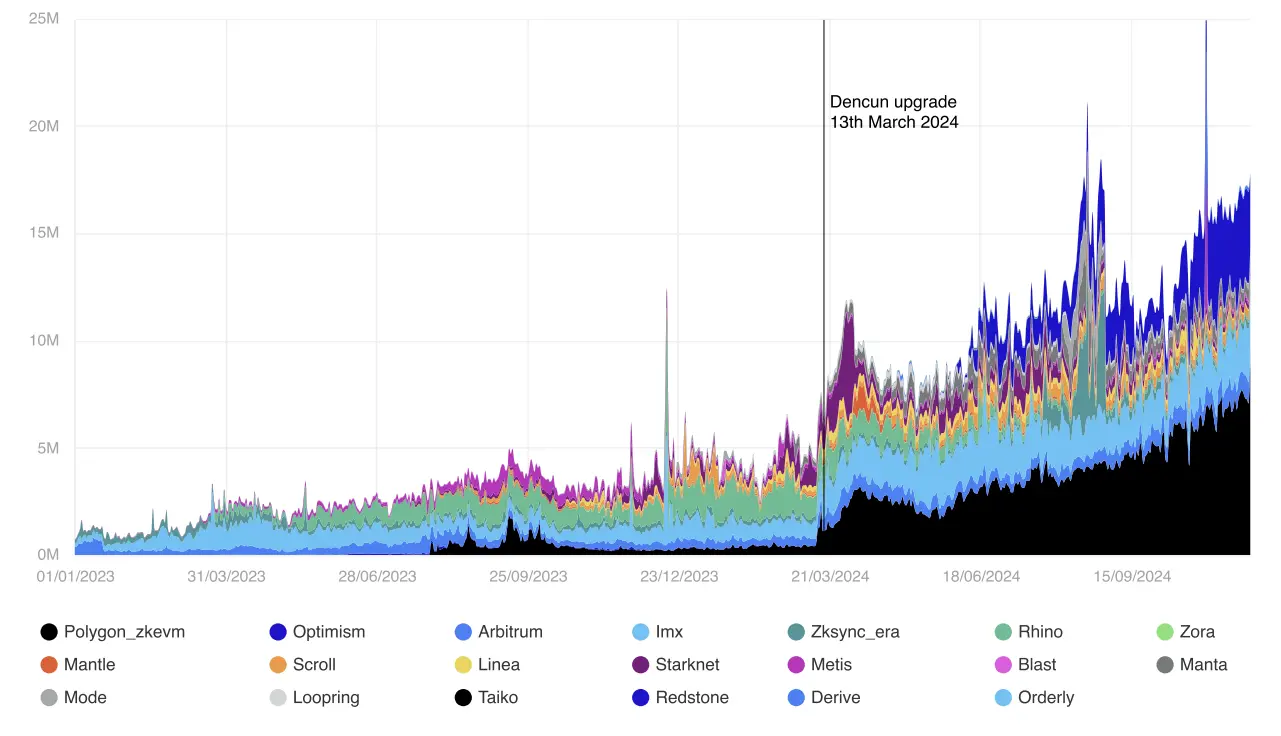
Daily transaction volume on Ethereum Layer 2 (excluding the Ethereum main chain). Source: GrowThePie, CoinShares, data available as of close 17 September 2024
Overall, Layer 2 adoption has undergone significant changes over the past year, especially following the Dencun upgrade, as shown on I2beat:

The x-axis represents: token use, one year ago, now, percentage change
Even far exceeding the current growth trend of Layer 2 adoption, large institutions are continuously advancing the development of new Layer 2 solutions. Earlier this year, Sony announced their Layer 2 network "Soneium," and recently, Kraken launched their "Ink" blockchain. The institutionalization of Layer 2 will further drive adoption, attracting users who are already clients of these enterprises in the coming year.
— Blob Market Dynamics
Even with a significant increase in usage, the Blob market—the independent fee market used by Layer 2 to publish transactions to Ethereum—has largely remained "free." The actual cost of publishing Blobs, separate from the transaction data itself, is influenced by mechanisms similar to those introduced in EIP-1559. In simple terms, each Ethereum block can publish a maximum of six Blobs; when the number of published Blobs exceeds three, the fees for publishing these Blobs increase, while when the number of published Blobs is less than three, the fees decrease until they reach the minimum possible fee.
Recently, at the end of October, we observed a period where the number of published Blobs consistently exceeded three, albeit for a short duration, which pushed the Blob market into a price discovery phase.
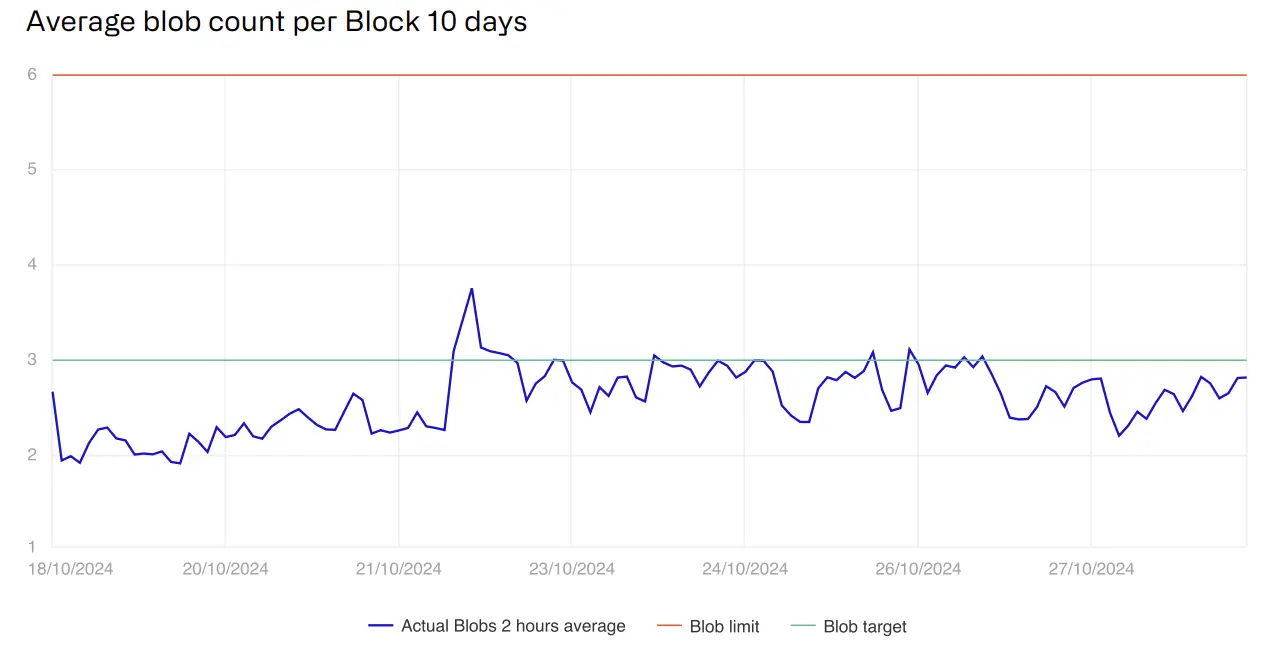
Average number of Blobs per block (past 10 days). Source: Dune Analysis, data as of 25th November 2024
This change stemmed from increased transaction demand due to users claiming Scroll airdrops. In our view, the competitive Blob market adds value to ETH tokens by increasing the amount of ETH burned. Greater competition among Layer 2 solutions in the Blob market will form the basis of our outlook for 2025: in the coming year, Layer 2 usage will continue to grow, activity will become more vibrant, and we will begin to see the continuation of Blob price discovery. This will mark the beginning of what many consider a healthy coexistence between Layer 2 and Layer 1 (L2-L1), which is at least healthier from a comparative perspective.
— Layer 2 Will Continue to Grow in the Coming Year
In addition to the institutional push for Layer 2 networks mentioned earlier, other factors suggest that our predictions may come true. For example, the Layer 2 network Base, supported by crypto giant Coinbase, has transparently outlined their plan to increase the gas target by 1 Mgas/sec each week until reaching 1 Ggas/s. In short, Base's plan is to continuously increase the transaction volume that each block can accommodate, thereby also increasing the transaction volume that Ethereum itself (as batch transactions) can handle.
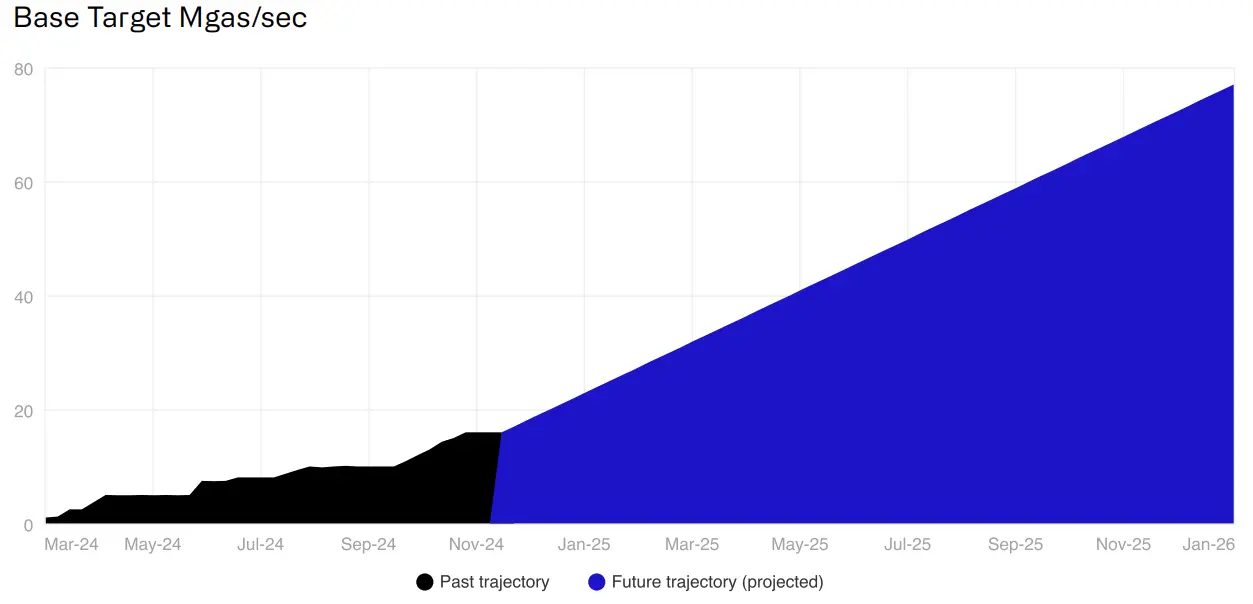
Base's target Mgas/sec. Source: Base, CoinShares, data available as of close 23 October 2024
Currently, there is no excess trading demand for Base, so there is not necessarily a need to raise the gas limit. However, one might wonder why the developers of Base choose to continuously increase capacity. As a reference, when gas reaches 80 Mgas/sec, Base can theoretically support around 3,800 TPS for simple transfers. At this level of demand, the number of Blobs published per block is almost certain to increase, and we will see the costs of publishing Blobs continuously rise, leading to an increase in ETH burned.
The continuous expansion of Base to accommodate more transactions is not without merit. Coinbase plans to further integrate Base with the Coinbase consumer application (i.e., payment channels), a process that has already begun, thereby deepening its approximately 100 million user base and providing a convenient pathway for broader Base adoption.
In our view, Layer 2 adoption will continue to increase, driving demand for Blobs and Ethereum transaction fees. According to our model, this outcome will be beneficial for the value of ETH and make Layer 2 an important source of demand for Ethereum once again.
Ethereum Plans to Implement the Pectra Upgrade in 2025
Author: LUKE NOLAN, Ethereum Research Assistant at CoinShares
The Pectra upgrade plans to make some key feature modifications to the internal mechanisms of the Ethereum blockchain as we know it. Initially, the Pectra upgrade was planned as a hard fork, but due to the large number of Ethereum Improvement Proposals (EIPs) within the original scope, developers decided to split these proposals into two separate upgrade versions. The Pectra upgrade is expected to be launched in the first quarter of 2025, while the newly proposed Fusaka upgrade is anticipated to be released in 2026.
— What Does the Pectra Upgrade Include?
The Pectra upgrade was originally planned to be the largest upgrade in Ethereum's history, containing 20 EIPs. After the split with Fusaka, the first hard fork is expected to include 10 EIPs. We will not discuss each of these 10 EIPs in detail but will focus on the most important one and explain why it is being implemented. The complete list of EIPs is as follows:
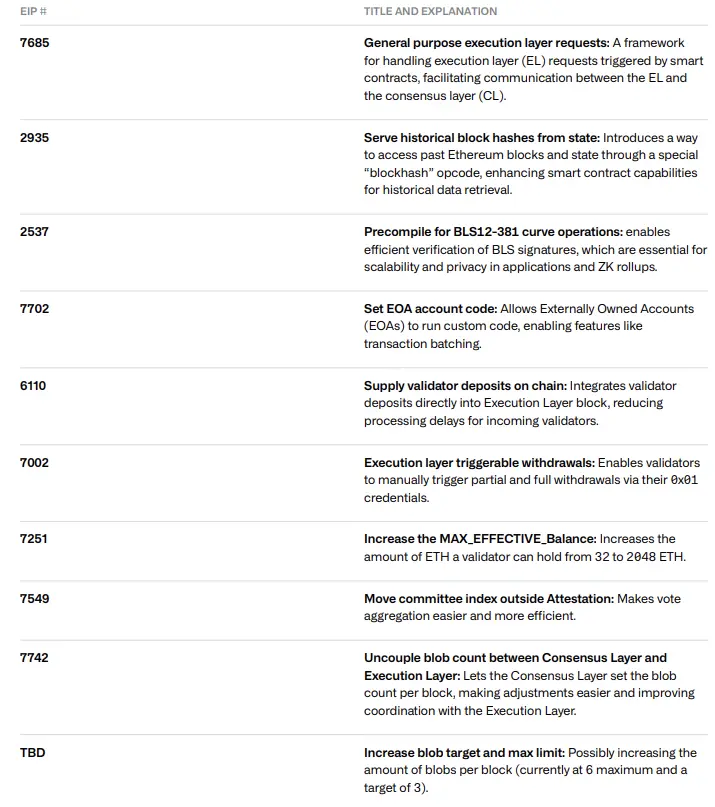
— EIP-7251: Maximum Effective Balance Adjustment
EIP-7251 is the proposal with the most significant impact on Ethereum. Currently, validators on Ethereum are limited to 32 ETH, a restriction initially intended to promote decentralization and increase participation. Over the past two years, the number of validators has grown significantly, now approaching 1.1 million (as of the time of writing, data sourced from Dune).
The side effect of this change is that as the number of validators increases, the number of P2P messages on the network is also rising. This affects the final confirmation speed of transactions.
EIP-7251 raises the amount of ETH a single validator can hold to 2048, allowing large entities to consolidate resources and reduce the number of validators they operate (for example, Coinbase currently has 122,000 validators and will only need to operate a maximum of 2,000 validators after the upgrade).
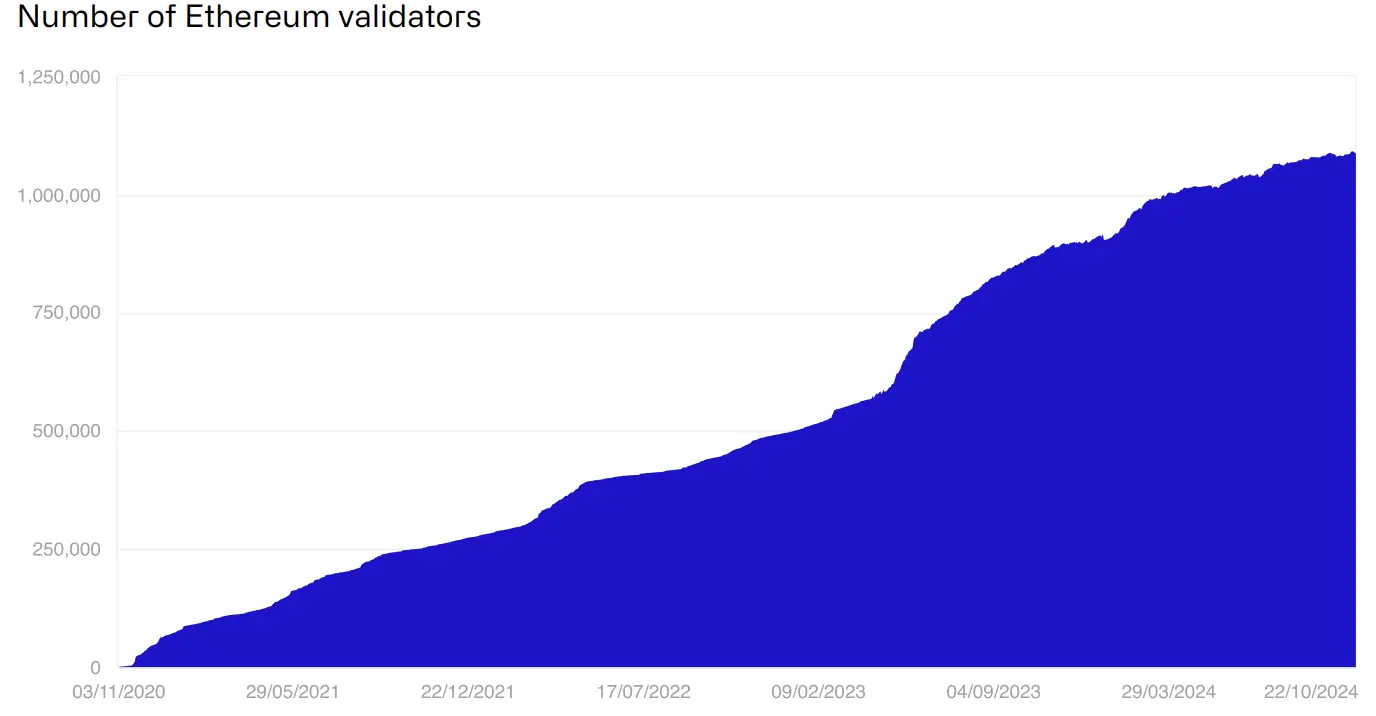
Number of validators on the Ethereum chain. Source: Bloomberg, CoinShares, data available as of close 03 November 2024
— How Does EIP-7251 Improve Ethereum?
Reduces Computational Burden: By increasing the maximum effective balance, validators can take on more responsibilities without needing to allocate their stakes across multiple validator nodes. This also means that large validating entities can slightly lower their operating costs (and simplify logistics).
Enables Single Slot Finality Path: Reducing the computational burden is a key step toward achieving single slot finality—meaning a block can be confirmed within a single slot (12 seconds). Single slot finality significantly shortens transaction confirmation times, enhancing the performance of decentralized finance (DeFi) protocols, as transactions can be confirmed more quickly (and irreversibly). This may also mean that end users can obtain better pricing from decentralized exchanges due to lower slippage and reduced risk of front-running attacks.
It is important to note that EIP-7251 will not affect rewards. An entity with 10 validators, each with 32 ETH, will have the same annual yield as a single validator with 320 ETH.
The proposal to increase the data block target (currently without an EIP number, as shown in the table above) aims to enhance Ethereum's scalability as a data availability layer, aligning with the rollup-centric roadmap. This proposal comes from Base developer Francis Li. As mentioned in other parts of this report regarding Ethereum, Base plans to continue expanding transaction capacity, with demand expected to grow accordingly. Currently, each block can accommodate a maximum of 6 data blocks, and this proposal increases it to 8, adjusting the target from 3 to 5. In our view, this may negatively impact the short-term outlook for ETH, as lower fees for end users could adversely affect the accumulated value of Ether. However, this should be seen as a short-term pain point in planning for the final state that handles millions of Layer 2 transactions daily.
Overall, Ethereum is constantly evolving, and the execution of the expansion roadmap brings new efficiencies while also presenting new challenges for Ether, particularly in balancing availability with value accumulation. It is clear that these changes are not suitable for short-term investors—developers are working hard to programmatically modify the network to adapt it to a state that can ultimately support various use cases and millions of daily active users.
Speed Release: The Parallel Revolution
Author: MAX SHANNON, CoinShares Research Analyst
As blockchain networks continue to grow, the demand for faster processing of more transactions is driving a shift toward parallelization—processing multiple transactions simultaneously to improve speed and efficiency. This innovation is crucial for establishing blockchain as a viable pillar of the global financial system, enabling thousands of transactions to be processed per second.
Solana was the first blockchain network to adopt parallelization, but this approach also faces challenges. Solana experienced network congestion issues in September 2021 and April 2022, leading to significant network outages. These interruptions highlighted a fundamental problem: balancing speed and reliability remains difficult under high transaction loads.
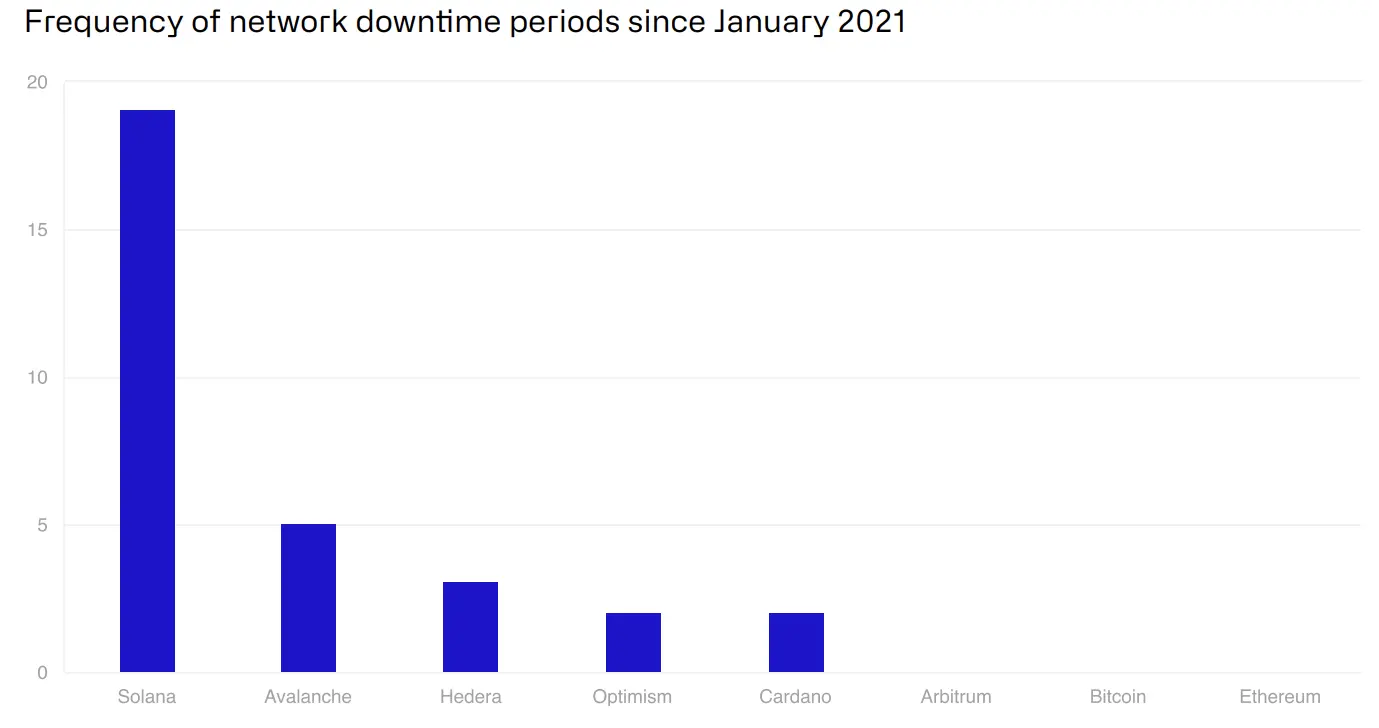
Frequency of network downtime since January 2021. Source: Network status pages, CoinShares, data available as of close 29 October 2024
This performance gap has opened the door for new competitors exploring alternative methods to improve parallel transaction processing. Two main strategies have emerged—optimistic parallelization and pessimistic parallelization.
In simple terms, pessimistic parallelization is more cautious, employing stricter controls to avoid errors but sacrificing some speed. Optimistic parallelization, on the other hand, focuses on speed, assuming transactions can be processed smoothly, although this approach may affect reliability in more complex scenarios. Each method has its pros and cons; pessimistic models offer more stability, while optimistic models perform better under ideal conditions.
Looking ahead, some strategies hold promise for further enhancing blockchain scalability. For example, reducing the computational steps required to generate transaction proofs could significantly accelerate processing speeds. Additionally, specialized hardware, such as GPUs and ASICs designed for high-intensity computational tasks, may also help push the boundaries of transaction throughput.
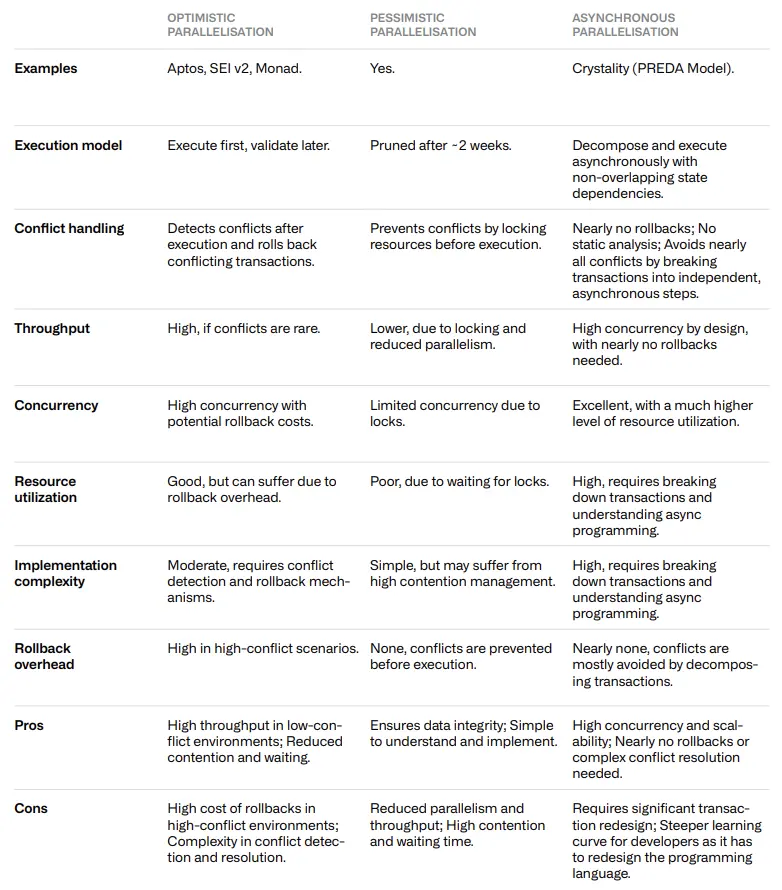
Source: Preda
Parallelization faces obvious challenges. One major challenge for distributed networks is achieving precise consensus on the temporal ordering of transaction history. Simultaneous processing of transactions may introduce dependencies at the transaction, block, and smart contract levels, which need to be carefully managed to maintain data order and consensus.
Parallelized networks may require more powerful and expensive nodes, which could hinder decentralization, as the network can only operate on a small subset of more deeply interconnected nodes. New "innovative" consensus mechanisms may also need to be invented to ensure network synchronization. All of this comes with its own risks and trade-offs.
In short, achieving high performance and stability in blockchain networks is no easy task, but despite the inherent trade-offs, teams are still pushing for further parallelization of the network. If successful, these efforts could make blockchain a scalable and reliable technology capable of supporting the demands of the future digital economy.
Firedancer Release: A Path to Solana's Dominance?
Author: MAX SHANNON, CoinShares Research Analyst
The future of Solana will be led by the transformative implementations of Frankendancer and Firedancer. With the implementation of Firedancer and Frankendancer, Solana's future will undergo a fundamental change. After implementation, three key objectives should be achieved: documentation and standardization of the code, diversification of the validator client pool, and enhancement of ecosystem performance. The overall goal is to revolutionize the user and developer experience:
Documenting and Standardizing the Solana Protocol: First, Firedancer will help document and standardize the Solana protocol. This will make future clients more accessible and easier to use.
Diversifying the Validator Client Pool: Second, Firedancer will promote the diversification of the validator client pool, reducing reliance on Solana Labs and Jito Labs (the only two clients currently validating the Solana blockchain). Ideally, Solana could have up to four independent validator clients, with no single client holding more than 33% of the stake, thereby improving network uptime, as even if one client fails, the others can continue to operate the blockchain.
Enhancing Solana's Performance: Third, and most excitingly, Firedancer has the potential to significantly enhance Solana's performance. With its excellent architecture, Firedancer utilizes FPGAs (Field Programmable Gate Arrays) to achieve microsecond-level latency and can handle up to 8 million signatures per second, promising unparalleled throughput and efficiency. However, this potential is currently limited by the throughput constraints of the Solana protocol, which currently supports a maximum of 81,000 TPS and faces further bottlenecks at 430,000 TPS due to sharding packaging limitations.
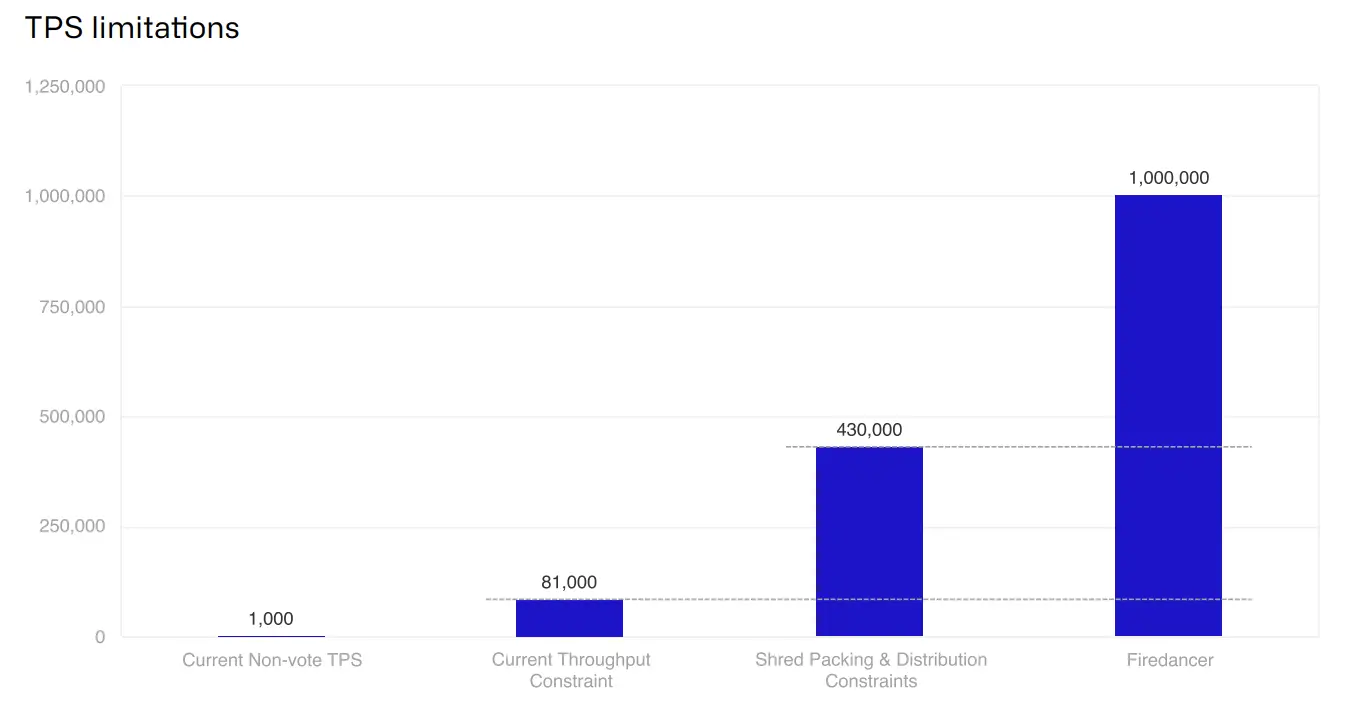
TPS Limit. Source: Bloomberg, CoinShares, data available as of 29 October 2024
Firedancer, as a brand new validator client, is built from scratch using C language, aimed at improving Solana's network, runtime, and consensus layer to enhance performance and scalability.
Frankendancer is a hybrid client that is currently running on the testnet, integrating components of Firedancer into the existing Solana system for incremental testing without disrupting the network. The goal is to gradually evolve Frankendancer into Firedancer while ensuring stability and unlocking significant performance improvements.
This upgrade has already gone live on the mainnet, but due to low-performance clients becoming a bottleneck for protocol performance, it will not have a direct impact on developer and user experience for the time being. Now, these low-performance clients need to align with higher open-source standards to accelerate the performance improvements of the protocol before the development of Firedancer.
In the future, limitations on protocol performance, such as the TPS cap, will need to be addressed through ongoing governance decisions and protocol updates. The success of Firedancer is not just a technical achievement but also involves community consensus and widespread adoption. As Firedancer develops, updates to the protocol will be necessary to fully leverage its capabilities, which may require adjustments to how the blockchain processes transactions and data.
免责声明:本文章仅代表作者个人观点,不代表本平台的立场和观点。本文章仅供信息分享,不构成对任何人的任何投资建议。用户与作者之间的任何争议,与本平台无关。如网页中刊载的文章或图片涉及侵权,请提供相关的权利证明和身份证明发送邮件到support@aicoin.com,本平台相关工作人员将会进行核查。




